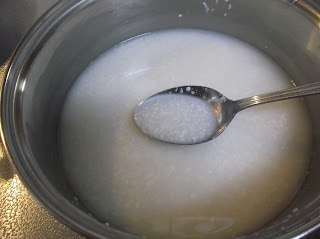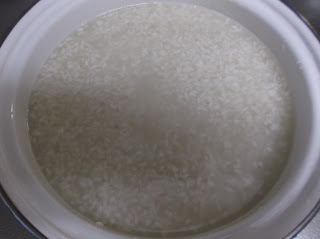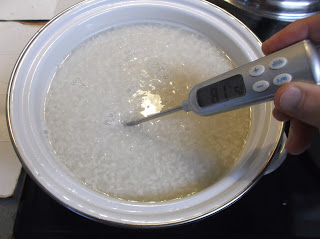Now that I have almost 2 kg of sake kasu in the fridge, I have to think of good ways to use it up before it goes bad.
冷蔵庫に酒粕が2キロ近くあるので、悪くなる前に使い切るいい方法を考えないといけません。
1. Sake kasu paste
1. 酒粕ペースト
The sake kasu I recently bought is called ita kasu (lit. sheet lees), which is hard to dissolve in water. Another type is bara kasu, which is crumbly.
私が最近買った酒粕は板粕で、水に溶けにくいタイプです。バラ粕というタイプもあり、これは崩れやすいです。
So, I tore some sake kasu into pieces by hand, put it in a measuring cup, added some hot water from the thermos flask, let it sit for hours to dissolve. The paste turned out very soggy. I should have added much less water! Anyway, I can put in some more sake kasu later to achieve the desired texture.
You can put such sake kasu paste to any dish you like to give it additional flavor
というわけで、酒粕を手で細かくちぎり、計量カップに入れて、魔法瓶のお湯を少し入れ、数時間放置して、溶かしました。ペーストはすごく水ぽっくなってしまいました。お湯はもっと少しにすべきでした!ともかく、後でもっと酒粕を足して、好みの硬さにできると思います。
このような酒粕をどんな料理にも入れて、風味を加えることができます。
2. Sake similar to nigori zake (lit. cloudy sake)
Just put some sake kasu paste to a glass of sake with some ice cubes.
2. にごり酒のようなお酒
酒粕ペーストを、お酒と氷の入ったコップに入れるだけです。
Left: Sake kasu pasteRight: Glass of sake with some ice cubes
左: 酒粕ペースト
右: お酒と氷を入れたコップ
I added two tbsp of sake kasu paste.
酒粕ペーストを大さじ2杯入れました。
Then, I stirred with a spoon. Perfect! I really liked it! Much, much better than regular sake!
そしてスプーンで混ぜました。完璧です!普通のお酒よりずっと美味しいです!
2. Yaki (grilled) sake kasu
2. 焼き酒粕
When I searched for good uses for sake kasu, I found a simple recipe: simply grill pieces of sake kasu in a toaster oven. Another recipe says to sprinkle sugar on the grilled sake kasu.
酒粕のいい使い道を探して、この簡単なレシピを見つけました。酒粕をオーブントースターで焼くだけです。焼き酒粕に砂糖を振り掛けるレシピもありました。
I grilled two pieces in the toaster oven until partially browned.
2切れ、オーブントースターで、部分的に黒くなるまで焼きました。
Well, I didn't like it, with or without sugar.
Now I have to think of other uses for sake kasu!
砂糖ありでもなしでも好きになれませんでした。
酒粕の使い道をもっと考えないと!
EDITED TO ADD:
追記:
Sake kasu contains about 8% alcohol (ethanol). I didn't want to evaporate the alcohol when making sake kasu paste, but if you do, you need to boil the sake kasu solution for some time, say, 2-3 minutes, to evaporate the alcohol.
酒粕にはアルコール(エタノール)が約8%入っています。私は酒粕ペーストを作る際にアルコールを飛ばしたくなかったのですが、飛ばしたい場合は、酒粕液をしばらく(2~3分)沸騰させ、アルコールを蒸発させて下さい。





























































